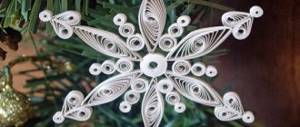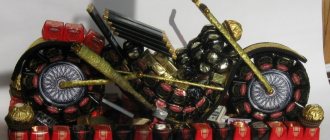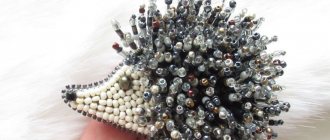Schematic diagram of a camera on one transistor
Mosfet field effect transistor pinout
Only 7 details separate you from an interesting device that produces real lightning bolts 5-10 centimeters long (and for some, even 15). The circuit can be safely recommended for beginner radio amateurs who already know how to handle 220V voltage. It is from him, directly, that the kacher feeds. On the one hand, this simplifies the matter, but on the other, it increases the risk.
I won’t write for the hundredth time that if a device has mains power, then you need to keep an eye out and play it safe. I will only say one thing - when starting up for the first time, carry out experiments with a 2-5 ampere fuse and a 100-200 watt incandescent light bulb connected in series with 220v. With it, the qualityr works less well, but you can already understand what works. But in case of accidental short circuits there will be no explosions, but the lamp will simply light up at full power.
Field effect transistor - any high-voltage Mosfet. SSH5N90 in the box and installed it. Before you put the whole thing in the case, you need to solder it by overhead mounting on a table and achieve reliable operation with maximum spark. At the same time, you will find out whether the selected parts work or not.
The circuit itself is soldered in an hour (with smoke breaks), but the coil takes longer. The primary winding is 4-5 turns of copper wire 1.5-2 mm. It can be even thicker, for stability, because it will hang in the air. The winding direction is not important, the location on the axis is the same - both at the base and in the center of the secondary it started well. Secondary, that is, high-voltage - 500-1000 turns of PEL 0.3. I used 500 and it worked great, I didn’t even cover it with epoxy. Pipe diameter - 30 mm.
Kacher Brovina from a 220 volt network | DIY master class
To make the device, we need a few parts, namely:
1. A choke for fluorescent lamps or a transformer mains winding. (preferably 100 watt) 2. Diode. (I took 31DQ104L, preferably more than 2 amperes, with a margin) 3. Ceramic or film capacitor marked 105 (1 uF) at 400 volts. 4. Two 50 kOhm resistors. and 10 kOhm. (variable resistors can be used) 5. Two zener diodes. 6.1. Field effect transistor, suitable for IRF740, IRFP460 and many others. (maximum voltage 350 V) 6.2. A bipolar transistor (if there is no field-effect transistor) is ideal for line transistors. 7. Cooling the transistor and inductor. (cooler and radiator) 8. Copper wire 0.10mm - 0.25mm 9. Network wire (preferably insulated) 10. Plumbing pipe 5cm - 11cm in diameter (small 2.5 is possible, but the effect will be worse)
Where can I get what?! You can take almost any diode, and they are in many circuits, most often at the power input as a diode bridge. (If it’s critical, you can try at 1 ampere, but if it gets hot, it’s better to change it) Capacitors should be on the TV boards and block boards power supply for various devices. Zener diodes are most often also found in power supplies. There are plenty of resistors in all boards, and if you don’t have the required value, you can connect them in series or in parallel. The wire is in transformers, in the network coil. (primary) Field-effect transistors are difficult to find and simply unsolder (they are available in the power supply, but it’s better to buy them), so you can take a bipolar transistor from the TV that is located near the line transformer. In summary: a TV or power supply is best suited as a donor. We also do not forget that you can replace all the elements with others and supply not 220 volts, but less, and the result will be the same, but the sparks (streamers) will be smaller. First, let's wind the secondary and primary coils. We wind more than 1000 turns of thin wire on the pipe. The more turns and the larger the diameter of the pipe, the better the effect. It is very important to wind the coil to the coil, without overlaps and in one layer. After finishing, we wrap the coil with tape or varnish it. If this is not done, then it may unravel and all your efforts will be in vain. (This is the secondary coil)
We make the primary coil around the secondary coil from the network wire. (5-15 turns) You may not be careful here, but for the sake of aesthetics you can try. You need to wind it in the same direction as the secondary coil.
Next, we assemble the diagram. I assembled everything with a canopy, since there are not many elements and there is simply no point in making a board. The transistor will heat up, so it must be screwed to the radiator; it is advisable to put a cooler on the throttle so that it does not heat up too much.
We solder the coils to the circuit and plug our kacher into the outlet. (220v) If nothing works for you, then you need to swap the leads from the primary coil. (The one with a thick wire) When everything works, you will see sparks coming from the wire from the coil. You can touch them with your hands! And other iron objects.
You can also put something iron on top and the power of the coil will increase!
If we bring an ordinary light bulb to the kacher, we will see beautiful plasma in the lamp, like in a plasma ball. (Caution: the lamp gets hot and may burst)
At a short distance, fluorescent lamps and gases in the flasks should light up.
Thank you all for your attention. If you have any questions, write in the comments. There are plans to create a singing kacher with an interrupter, but this requires materials, and there is currently no money to purchase them.
Where should I put it all?
The eternal problem is a good body. Despite a couple of computer power supplies in which some install such circuits, I decided not to use metal. For better electrical safety. After all, we’re not assembling a flashing light!
After some thought, I took as a basis a piece of plastic pipe 120x200 mm, from a kitchen hood. It's round and looks good. It will contain a circuit, a field-effect transistor with a radiator, and a primary circuit. And a secondary with a sharp copper knob will stick out from above.
The top of the case is closed with a lid from a box in which seaweed is sold. It fits perfectly in diameter.
It fits perfectly in diameter.
A slot is made in the lid for the coil, and so that they do not look inside, it is covered with black self-adhesive tape.
The coils were attached to the body through a fiberboard strip left over from the renovation of the balcony, with mounting posts for connecting the three necessary wires.
When designing, keep in mind that the radiator for the transistor requires more than a pack of cigarettes; a small one will get very hot, so you won’t run the heater for a long time. I stopped at 50x100x5 mm, but after 10 minutes it becomes hot.
The second most important thing, after the coil, is the choke. A lot depends on him. A choke inductance of more than 1 Henry and a current of 1 ampere are required. I tried primary ones from network transformers: up to 50 watts it doesn’t work at all, 50-100 watts is good, 100-200 is excellent. It was just a pity to install such powerful ones, so I limited myself to the 60-watt TN42 .
We place everything in a case on a metal base, to which a choke, a radiator, and, if anyone wants, a printed circuit board are screwed. I didn’t make it - I assembled it by hanging it.
The outside of the body is also covered with self-adhesive tape, and the coil is wrapped with black electrical tape. I was afraid that it would work poorly with her, but it worked out.
After placing it in the case, we turn it on again not directly to 220V, but through a fuse lamp. There may be no sparks with it, but the rumbling of the circuit and the glow of the neon light near the coil will tell you that everything is all right.
Brovin Kacher on a field-effect transistor with a chopper
The main advantage of this device is the ability to regulate high-voltage discharges emanating from the terminal.
Parameters: Consumption 3.4 amperes Supply voltage 220-250 volts Power 800 watts
Schematic diagram:
Brovin kacher circuit on a field-effect transistor with a chopper
Principle of operation
The diagram shows that the device consists of three parts: a power supply, a control unit (breaker) and the camera itself. The control unit is used to adjust the frequency and duty cycle of pulses that arrive at T1 (mosfet), which, in time with the frequency, opens and closes, opening the transition between drain and source. Thus, current begins to flow through the open junction, closing the quality circuit to the power supply, and a pulse is obtained. During this short period of time, a spark runs through the terminal. I’ll describe how it all works in a simple way: voltage appeared on the power supply (current went in 2 directions to the breaker and to T1), the breaker turned on, sent an impulse to the gate of T1, the gate opened the junction, current flowed through the switch and the circuit was closed.
What to replace with what and how to make it work?
Control unit (breaker)
The chopper can be replaced with any rectangular pulse generator, but in this article there is only one, so let’s look at it in more detail. All values of the parts of the microcircuits can be changed by 10-30%, but in this case the circuit will work differently, I recommend setting the generator frequency to 150 Hz. This formula determines the frequency:
power unit
The entire device is powered from a 220-volt network; a 5-amp fuse is installed for protection. The kacher itself is powered by 310 volts (220 volts rectified), I recommend using a diode bridge with a current of at least 10 amperes and a voltage of at least 500 volts. The breaker is powered separately through a 220/12 volt isolation transformer through a 1 ampere 50 volt diode bridge and is shunted by a capacitor.
Kacher
In quality, parts can be deviated by 10-20% of their nominal value. The field-effect transistor can be replaced with any similar or more powerful one, which I advise you to do. You adjust the loop capacitor yourself; 0.5-1 µF is optimal and is not needed for pulse mode.
Reels
The primary winding of the kacher is made with a wire of 2 squares, the number of turns is from 4 to 10. The secondary winding is wound with high-quality PLSHO 0.25 mm or any other, the number of turns is from 500 to 1000 (there is no more sense), I advise you to cover everything with varnish or epoxy resin at the end of the winding. Choke L1 has a resistance of 15-40 ohms; it is located in LDS lamps; it can be replaced with a resistor with the same resistance and a power of at least 100 watts.
Kacher's photo
Control unit with power button.
Electronics.
Attached files:
breaker signet (26 KB)
cxem.net










